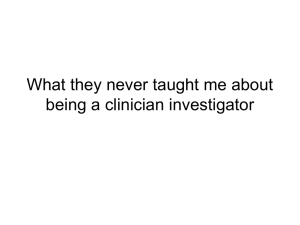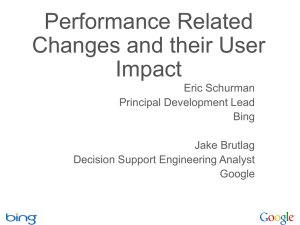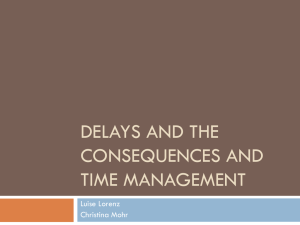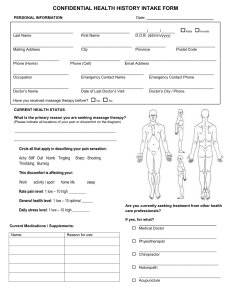ecognizing Developmental Delays
advertisement
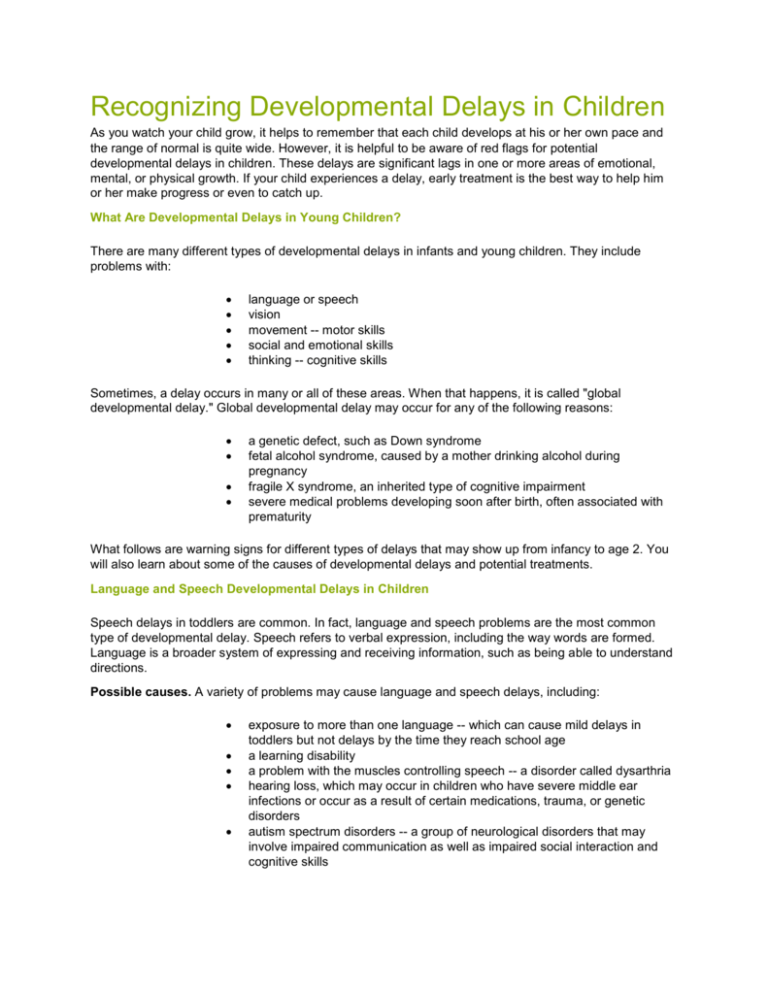
Recognizing Developmental Delays in Children As you watch your child grow, it helps to remember that each child develops at his or her own pace and the range of normal is quite wide. However, it is helpful to be aware of red flags for potential developmental delays in children. These delays are significant lags in one or more areas of emotional, mental, or physical growth. If your child experiences a delay, early treatment is the best way to help him or her make progress or even to catch up. What Are Developmental Delays in Young Children? There are many different types of developmental delays in infants and young children. They include problems with: language or speech vision movement -- motor skills social and emotional skills thinking -- cognitive skills Sometimes, a delay occurs in many or all of these areas. When that happens, it is called "global developmental delay." Global developmental delay may occur for any of the following reasons: a genetic defect, such as Down syndrome fetal alcohol syndrome, caused by a mother drinking alcohol during pregnancy fragile X syndrome, an inherited type of cognitive impairment severe medical problems developing soon after birth, often associated with prematurity What follows are warning signs for different types of delays that may show up from infancy to age 2. You will also learn about some of the causes of developmental delays and potential treatments. Language and Speech Developmental Delays in Children Speech delays in toddlers are common. In fact, language and speech problems are the most common type of developmental delay. Speech refers to verbal expression, including the way words are formed. Language is a broader system of expressing and receiving information, such as being able to understand directions. Possible causes. A variety of problems may cause language and speech delays, including: exposure to more than one language -- which can cause mild delays in toddlers but not delays by the time they reach school age a learning disability a problem with the muscles controlling speech -- a disorder called dysarthria hearing loss, which may occur in children who have severe middle ear infections or occur as a result of certain medications, trauma, or genetic disorders autism spectrum disorders -- a group of neurological disorders that may involve impaired communication as well as impaired social interaction and cognitive skills Types of treatment. If you or your child’s doctor suspects a speech delay problem, seek an evaluation by a speech-language pathologist. This specialist may test your child’s hearing and use speech therapy with your child. The specialist or doctor may also suggest that you: communicate more with your child -- talk, sing, and encourage repetition read daily to your child reinforce speech and language throughout the day get treatment for middle ear infections Warning signs of speech or language delays. Contact your child's doctor if your child has any of the following signs at the age that's indicated. In addition, watch for any loss of skills that have already been learned. By 3 to 4 months, contact the doctor if your child: does not respond to loud noises does not babble begins babbling but does not try to imitate sounds (by 4 months) By 7 months, contact the doctor if your child: does not respond to sounds By 1 year, contact the doctor if your child: does not use any single words (like "mama") By 2 years, contact the doctor if your child: cannot speak at least 15 words does not use two-word phrases without repetition; can only imitate speech does not use speech to communicate more than immediate needs Vision Developmental Delays in Children Until 6 months, a newborn's vision is normally blurry. Then it improves as the child begins to coordinate sight in both eyes. However, sometimes this does not happen or other vision problems show up. Possible causes of vision delays. Refractive errors, such as nearsightedness and farsightedness, are common in children. Other eye problems include: amblyopia (lazy eye), poor vision in one eye infantile cataracts -- a clouding of the eye's lens -- or another inherited problem (these problems are rare) retinopathy of prematurity, an eye disease that sometimes affects premature infants strabismus -- also called cross eyed -- eyes that turn in, out, up, or down Types of treatment for vision delays. Early treatment can help correct many vision problems. Depending on the eye problem your child has, he or she may need: glasses or contacts special glasses surgery an eye patch Warning signs of vision problems. Contact your child's doctor if your child has any of the following signs at the age that’s indicated. In addition, watch for any loss of skills that have already been learned. By 3 months, contact the doctor if your child: does not follow moving objects with his or her eyes does not notice hands (by 2 months) has trouble moving one or both eyes in all directions crosses eyes most of the time By 6 months, contact the doctor if your child: has one or both eyes turning in or out all the time experiences constant tearing, eye drainage, or sensitivity to light does not follow near objects (1 foot away) or far objects (6 feet away) with both eyes If your child's doctor notes any problems, the doctor may refer your child to an ophthalmologist for further evaluation. Motor Skill Developmental Delays in Children Developmental delays may be related to problems with gross motor skills, such as crawling or walking, or fine motor skills, such as using fingers to grasp a spoon. Possible causes of motor skill delays. Children who are born prematurely may not develop muscles at the same rate as other children. Children who have been institutionalized, lacked stimulation at young ages, or have autism may have sensory integration dysfunction, a diagnosis questioned by the American Academy of Pediatrics. This complex disorder has been thought to cause a variety of problems with the senses, including: extreme reactions to touch, textures, or pain fearful reactions to ordinary movements or an excessive need to seek out sensory input such as, for example, by rocking, spinning, or hand-flapping problems planning and coordinating movement Other possible causes of motor delays include: ataxia, a genetic defect that impairs muscle coordination cerebral palsy, a condition caused by brain damage near the time of birth cognitive delays myopathy, a disease of the muscles problems with vision spina bifida, a genetic condition causing partial or total paralysis of the lower part of the body Motor Skill Developmental Delays in Children continued... Types of treatment for motor skill delays. Your child's doctor may suggest taking certain steps at home to encourage more physical activity. Your child may also need physical therapy for gross motor delays. Certain types of physical or occupational therapy may help with fine motor problems or sensory integration dysfunction. Warning signs of motor skill delays. Contact your child's doctor if your child has any of the following signs at the age that's indicated. In addition, watch for any loss of skills that have already been learned. By 3 to 4 months, contact the doctor if your child: does not reach for, grasp, or hold objects does not support his or her head well does not bring objects to his or her mouth (by 4 months) does not push down with legs when his or her feet are placed on a firm surface (by 4 months) By 7 months, contact the doctor if your child: has stiff and tight or very floppy muscles flops his or her head when pulled into a sitting position reaches with one hand only or does not actively reach for objects has trouble getting objects to his or her mouth doesn't roll over in either direction (by 5 months) cannot sit up without help (by 6 months) does not bear weight on his or her legs when you pull him or her up to a standing position By 1 year, contact the doctor if your child: does not crawl drags one side of his or her body while crawling cannot stand when supported By 2 years, contact the doctor if your child: cannot walk (by 18 months) does not develop a heel-to-toe walking pattern or walks only on toes cannot push a wheeled toy Social and Emotional Developmental Delays in Children Children may experience problems interacting with adults or other children, called social and/or emotional developmental delays. Usually these problems show up before a child begins school. Possible causes. Some causes of social and emotional delays include: neglect from early institutionalization or parental neglect ineffective parenting or attachment problems cognitive delays Another common cause of social and emotional developmental delays is pervasive developmental disorder (PDD). This group of disorders also causes communication problems ranging from mild to severe. PDD includes: autism, a complex yet common disorder Asperger's syndrome childhood disintegrative disorder Rett syndrome Types of treatment. There is no known cure for PDD. However, treatment may include: special types of behavioral and skill-oriented therapy medication if therapies do not work As with most types of delays, early treatment can make a big difference in the progress your child makes. Depending upon the diagnosis, treatment may also include play therapy or steps to aid attachment between parent and child Warning signs of social or emotional delays. Contact your child's doctor if your child has any of the following signs at the age that’s indicated. In addition, watch for any loss of skills that have already been learned. By 3 months, contact the doctor if your child: does not smile at people does not pay attention to new faces, or seems frightened by them By 7 months, contact the doctor if your child: refuses to cuddle shows no affection for parents or caregivers shows no enjoyment around people cannot be comforted at night (after 5 months) does not smile without prompting (by 5 months) does not laugh or squeal (by 6 months) shows no interest in games of peek-a-boo (by 8 months) By 1 year, contact the doctor if your child: shows no back-and-forth sharing of sounds, smiles, or facial expressions (at 9 months) shows no back-and-forth gestures, such as waving, reaching, or pointing Cognitive Developmental Delays in Children Problems with thinking, or cognitive delays, may occur due to one or more of these reasons: genetic defects significant medical problems soon after birth exposure to something harmful in the environment, such as a toxin Possible causes. Causes of cognitive delays include: a wide range of different learning disabilities exposure to alcohol or toxins before birth or afterward, including lead poisoning institutionalization or neglect during infancy or early childhood Down syndrome and other genetic disorders pervasive developmental disorder severe newborn medical problems Types of treatment for cognitive delays. As with most types of developmental delays, early treatment can make a big difference in the progress your child makes. Educational intervention can help your child develop specific cognitive skills. Educators and therapists may also recommend specific steps you can take at home to help your child. Warning signs of cognitive delays. Contact your child's doctor if your child has any of the following signs at the age that's indicated. In addition, watch for any loss of skills that have already been learned. By 1 year, contact the doctor if your child: does not search for objects that are hidden while he or she watches does not use gestures, such as waving does not point to objects or pictures By 2 years, contact the doctor if your child: does not know the function of common objects, such as a hairbrush, telephone, or spoon does not follow simple instructions does not imitate actions or words Remember: There is a wide range of normal development in children. Most developmental delays in children are not serious and children eventually catch up. Even children who do have serious delays can make big improvements when treatment begins as early as possible. If you have any doubts, talk to your child's health care provider.
